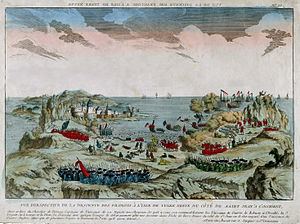20–40 dead or wounded800 captured 4–5 dead19 wounded Designated 1951 Result British victory | Official name Signal Hill Date 15 September 1762 | |
 | ||
800+ regulars 1,159 regulars and provincials, unknown number of warships, no more than 10 field cannons Similar Battle of Fort Beauséjour, Battle of Fort Ligonier, Seven Years' War, Battle of the Thousan, Battle of Beauport | ||
The Battle of Signal Hill was fought on September 15, 1762, and was the last battle of the North American theatre of the Seven Years' War. The British under Lieutenant Colonel William Amherst forced the French to surrender St. John's, which they had seized earlier that year in a surprise attack.
Contents
Background
By 1762 France and Britain had been fighting for eight years, and both were now contemplating a peace agreement. Britain's long blockade of the French coast had forced the French economy into a decline – and had prevented the French navy from going to the aid of France's colonies around the globe – leading to a large number being captured. To rebuild the French navy in the years of peace, it was believed that they needed access to the Newfoundland fishery and so an expedition was planned to take the island in anticipation of the coming peace negotiations. This occurred in May 1762 when a small force under the Chevalier de Ternay slipped out of Brest and past the blockade and headed out into the Atlantic.
French occupation
On June 27, 1762, the French forces under the Comte d'Haussonville forced the British capitulation of St. John's. During the following weeks, d'Haussonville, under the orders of the Chevalier de Ternay, was able to consolidate the French position in Newfoundland. His defence system consisted of several advance posts equipped with artillery around Signal Hill, a strategic point dominating the surrounding area.
On September 13, 1762, the British landed at Torbay, a few miles to the north. Ternay and Haussonville were unable to counter it, so to hamper the British advance, they dispatched a detachment to guard the bare summit of Signal Hill.
Battle
At dawn on September 15, 1762, Royal Navy warships anchored behind the steep hill, with masts out of view of the French. British troops then scaled the cliff side onto the hill itself. The surprise was total, and the engagement was brief but fatal.The commander of the French detachment, Guillaume de Bellecombe, was seriously wounded. On the British side, a bullet shattered the legs of one of Amherst's officers, MacDonell. The French withdrew to the fort. The British began painstakingly bringing artillery pieces up the cliff and constructed small batteries which they proceeded to use to bombard the fort, until the French capitulated.
Aftermath
At the close of the battle, Signal Hill was in the hands of the British. Strengthened by this advantageous situation, they obtained the capitulation of the French garrison numbering 800 men of St. John's three days later.
